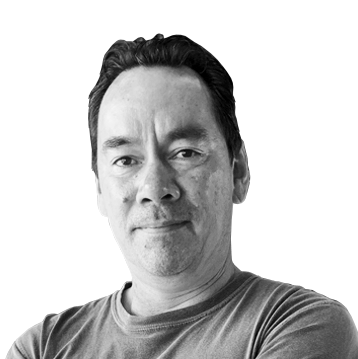The fourth-generation Subaru WRX has finally lobbed into Oz. Hallelujah for that, and not just because of the two-year wait since the launch of the Impreza it’s built on.
Rather, Japan has been in desperate need of affordable and practical performance to put the nation back on the motoring map.
A rocket ship no 86/BRZ, ageing MX-5 or go-fast Nissan can substitute for. A mass-produced, hero car of turbocharged and all-paw persuasions Japan set the mould for in the ’90s – a mould it’s largely ignored for far too long.
Of course, it was 20 years ago when the first WRX lobbed into Oz, a bombshell that rattled local perceptions of what affordable performance meant: big, V8 rear-driven sedans. And it would take another decade – and two generations of WRX – before anything else on the local market could supplant Fuji’s feisty halo car as the buck banging cult car of Aussie choice. That’d be the Golf GTI, specifically the Mark V version of the mid-Noughties.
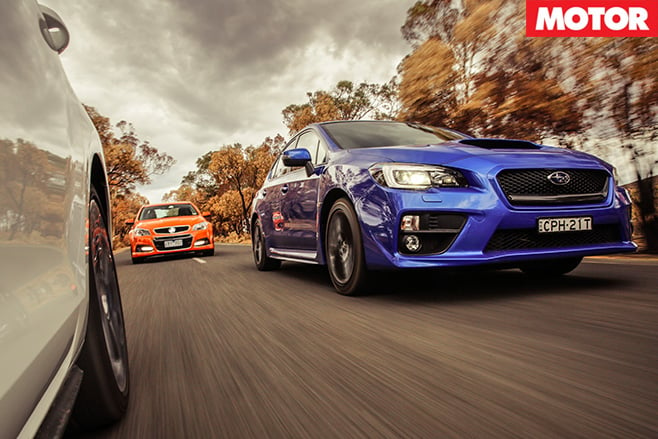
Now, in 2014, the Aussie Commodore SS-V, WRX and GTI nameplates remain the main performance protagonists at the thick end of the $50K price point.
The Holden, at $45,490 in manual form (our test car is the $47,690 auto), is perhaps the finest cut-priced sporting Aussie muscle car to date. It’s also, obviously, among the breed of Oz-spun V8 rear-drivers living on borrowed time. Fine. But that’s not to say the big Holden isn’t the best (big) banger for a reasonable buck.
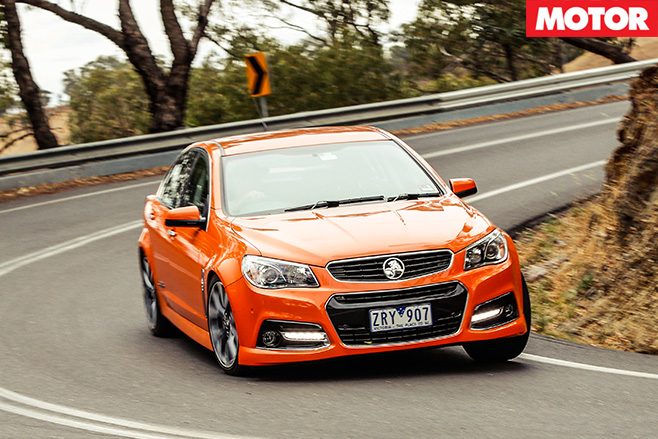
It undercuts the SS on price – $41,490 in as-tested manual form, $43,990 for the DSG version – and is, frankly, the car to beat. Which brings us to the completely revamped and largely unknown WRX.
The basic manual lobs in at a super-sharp $38,990 – about a grand cheaper than its predecessor. Add two grand to to get the, erm, self-shifting version – more on that shortly. Subaru also offers a Premium spec, chock full of up-market niceties for $43,990 – say hello to our test car – or $45,990 version depending on transmission choice.
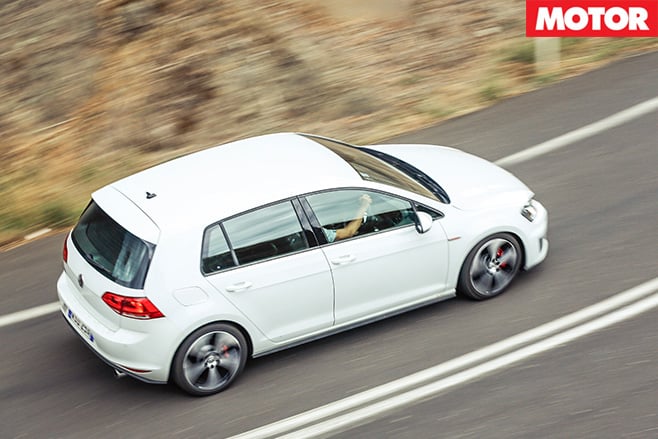
Gone is the EJ family engine and 2.5 litres of capacity, replaced with a new ‘FA20’ 2.0-litre boxer that shares its perfectly square bore-and-stroke ratio of 86 x 86mm with the BRZ and not the lethargic long-stroke (90mm) engine of the current Impreza.
It’s direct injected and boasts 197kW at 5600rpm and 350Nm between 2400 and 5200rpm, a lift of four kilowatts and five Newton metres over the old EJ, but with a vastly broader mid-range torque spread.
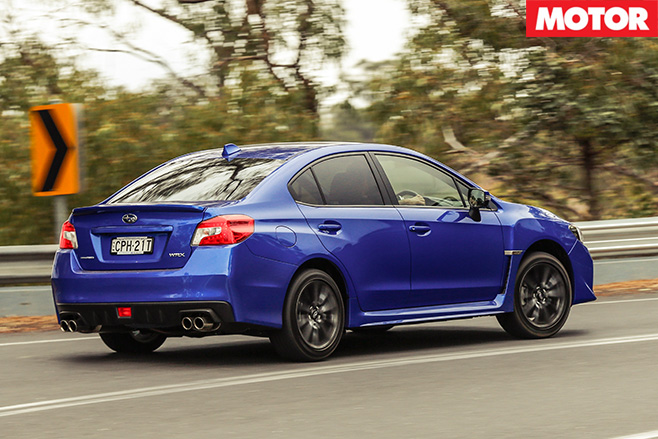
Transmissions? Subaru has ditched the ye-olde five-speed manual, replacing it with – hooray! – a proper six-speed. Gone, too, is the option of a conventional automatic. In its place is – shock, horror – a continually variable transmission (CVT), essentially an nfinite-speed device that engineers have bestowed with an “eight-speed manual mode” function in its most aggressive ‘Sport #’ setting, to sort of fake the feel of upshifts. The jury’s still out on that one.
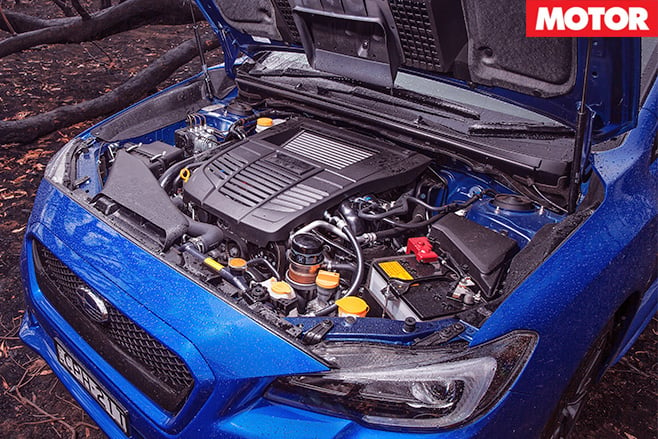
The brakes are bigger – purportedly offering 140 per cent of the old car’s stopping power. It’s also been completely redesigned inside the roomier cabin. All this and we haven’t even discussed looks.
Opinions are subjective and divided among the MOTOR crew. If you think it looks arresting in pics, wait until you see it in the flesh. I guarantee you won’t miss it in a crowded car park.
My take is this. It looks good nose on – less so from behind. And it falls over from most other (disad)vantage points. Apparently only roof and boot panels are common with Impreza, and it retains the base car’s slab-sizedness and gaping greenhouse which, if anything, is accentuated by the pumped guards. And these guards make the 17-inch rims – a rim size WRX has been running for well over a decade – look puny. It also looks very fussy, like there was a sale on bodylines and Subaru grabbed them all.
Put it this way – Subaru proved it could create design brawn and beauty with great success in the WRX Concept (which sat on 20s). Why then settle for this?
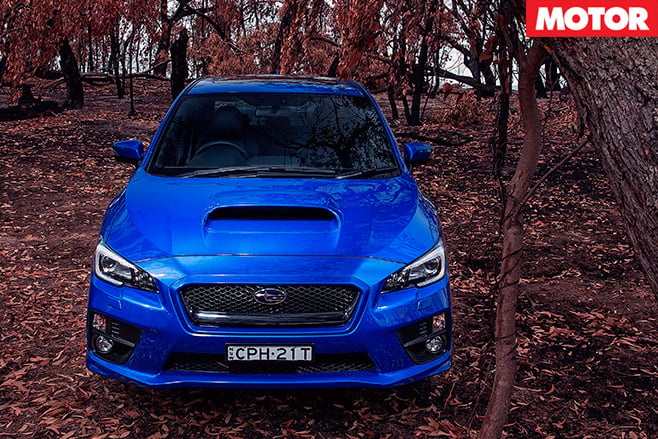
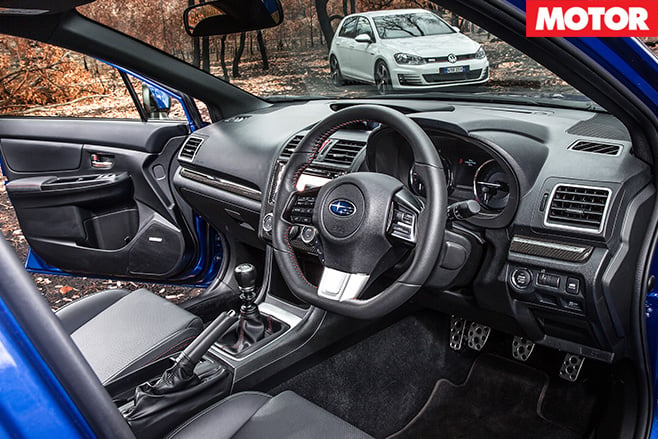
The good bits? The WRX’s new, small, multi-function wheel is neat, there’s a proper handbrake (unlike either the VW or Holden), and the digital displays in the instrument cluster and dash fascia are vast improvements over old. The seats, while offering noticeably firmer bolstering than the Holden, aren’t nearly as nicely sculpted to the torso as the GTI’s superb pews.
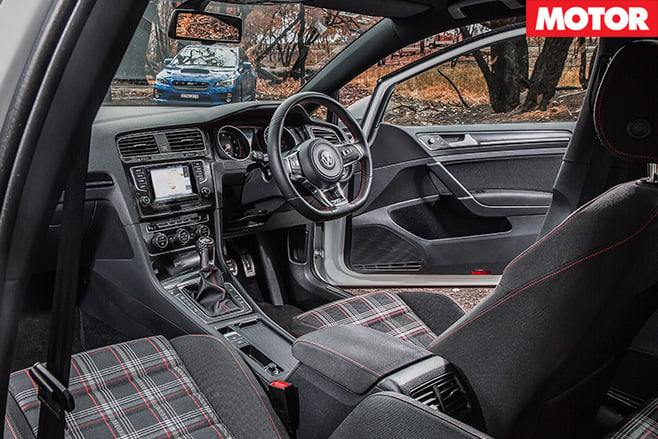
It piles on punch with an immediacy the GTI, with its more modest 162kW and 350Nm, can’t match. You notice the WRX’s thick swathe of torque – get some revs onboard and there’s that nice, boosty, old-school rush some punters wholly and solely buy into the turbo experience for.
Thing is, it’s not terribly linear in delivery. Engine delivery flattens out above 5500rpm despite the tacho suggesting another 1200rpm to play with, and below 3000rpm it needs a little bit of a wake-up call when you sink the boot in, particularly in the taller gears. By which time the Commodore, with its six litres of 260kW/517Nm shove and responsive auto trans kick-down, is marching off somewhere near the far horizon.
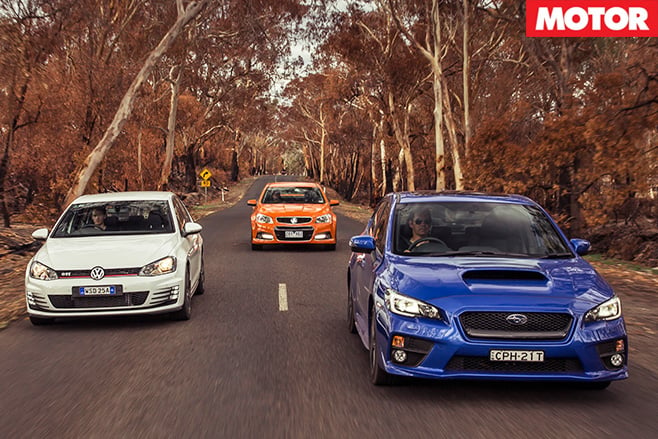
Thing is, the Rex should be a mid-five prospect for the 0-100km/h sprint, but it wants to bog its engine down on the sticky strip surface. The upshifts are slow through the notchy six-speeder’s gating, its ratios are so tightly stacked that an extra shift up to third is required to hit 100km/h and it’s tricky to find the bite point in the clutch pedal, leaving you little choice but to dump the thing off the line.
Tellingly, the terminal speeds for both cars are an identical 157km/h, despite the GTI lacking the advantages of power or all-paw traction.
The SS, meanwhile, rattles off a commanding 6.1sec to 100km/h and 14.2sec to 400m. And this is far from the quickest SS we’ve tested. The Commodore’s heft also factors into rolling acceleration, its 3.8sec 80-120km/h time just one-tenth quicker than the WRX and two-tenths up on the GTI.

The Japanese car runs electric power steering, though it feels for all the world like a hydraulic system – honest and old-school, if a little cumbersome in low-speeds. Surprisingly, the Commodore’s steering is much lighter in weight and vaguer in feel.
Meanwhile, our GTI – which benefits from adaptive smarts in its electric set-up – transitions from light (Normal) to heaviest-of-the-pack (Sport) depending on which mode of its DCC system is selected. Frankly, the Golf’s steering is daylight ahead of its rivals: the clarity of feel, its linearity and the amount of genuine feedback amplified through the loaded-up front tyres.
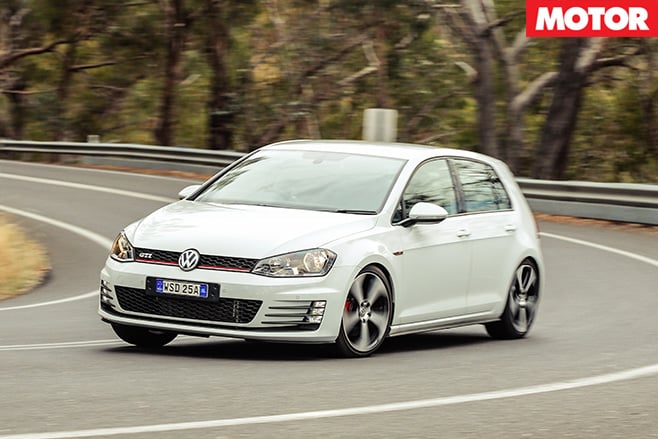
Nor does the Commodore present much in the way of front-end purchase or accuracy. It’s a big car, it demands guidance at turn-in and rolls around with the relative looseness you’d expect from a car two segments larger than its immediate rivals.
And yet it’s an absolute hoot, particularly exiting a corner under throttle. The SS really strikes a nice handling balance between its mass, its rubber footprint and the energy from its V8 heartbeat. Every squeeze of the loud pedal gets the tail cocked ever so slightly and it’s a doddle to steer the thing on the throttle while it digs in and channels its energy. On balance, it’s probably the most fun of the three… until you want to stop.
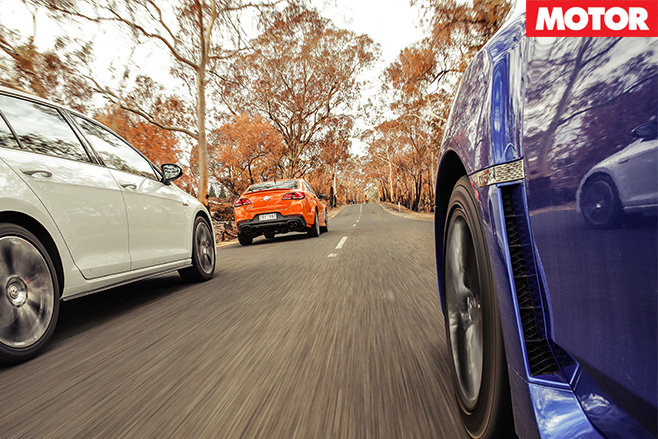
The Subaru is keener on turn-in and its shove exiting the corners palpable. Putting a decent set of rubber under the WRX has done the breed wonders, especially compared with recent forebears. This newfound accuracy in the chassis is most welcome. Balance the throttle and the Subaru shimmies around, or lift off and it will tuck its nose.
Give it stick, though, and it’s clear the tyres and suspension are doling out the talent. There’s not a lot of positive intervention from the all-paw system other than pulling the nose into power understeer and not a huge degree of proactive torque shuffling fore and aft to tug the chassis in the desired direction. The brakes, too, feel a little wooden underfoot.

It grips up better and you can lean into it harder than either the WRX or SS and it stops pretty damn confidently. A-to-B, it’s the most engaging and satisfying driver’s car here.
Add the Golf’s pack-leading depth of quality, refinement, ride comfort and primo flair and the GTI proves you don’t have to be the quickest device on the block to be the best. And thus, the status quo remains unchanged.
| u00a0 | u00a0 | Subaru WRX | u00a0 | Commodore SS-V | u00a0 | Volkwagen Golf GTi |
| Body | u00a0 | 4-door, 5-seat sedan | u00a0 | 4-door, 5-seat sedan | u00a0 | 5-door, 5-seat hatch |
| Drive | u00a0 | all-wheel | u00a0 | rear-wheel | u00a0 | front-wheel |
| Engine | u00a0 | 1998cc flat-4, DOHC, 16v, turbo | u00a0 | 5967cc V8, OHC, 16v | u00a0 | 1984cc in-line 4, DOHC, 16v, turbo |
| Bore/Stroke | u00a0 | 86.0 x 86.0mm | u00a0 | 101.6 x 92.0mm | u00a0 | 82.5 x 92.8mm |
| Compression | u00a0 | 10.6:1 | u00a0 | 10.4:1 | u00a0 | 9.6:1 |
| Power | u00a0 | 197kW @ 5600rpm | u00a0 | 260kW @ 5700rpm | u00a0 | 162kW @ 4500-6200rpm |
| Torque | u00a0 | 350Nm @ 2400-5200rpm | u00a0 | 517Nm @ 4400rpm | u00a0 | 350Nm @ 1500-4400rpm |
| Redline/Cut | u00a0 | 6600rpm/NA | u00a0 | 6000rpm/NA | u00a0 | 6000-7200/7200rpm |
| Power-to-weight | u00a0 | 138kW/tonne | u00a0 | 148kW/tonne | u00a0 | 122kW/tonne |
| Consumption | u00a0 | 14.9L/100km (tested) | u00a0 | 18.1L/100km (tested) | u00a0 | 10.9L/100km (tested) |
| Emissions | u00a0 | 213g/km (claimed) | u00a0 | 274g/km (claimed) | u00a0 | 153g/km (claimed) |
| Transmission | u00a0 | 6-speed manual | u00a0 | 6-speed auto | u00a0 | 6-speed manual |
| Weight | u00a0 | 1424kg | u00a0 | 1754kg | u00a0 | 1324kg |
| Suspension | u00a0 | strut, coil springs, anti-roll bar (f); double-wishbone, coil springs, anti-roll bar (r) | u00a0 | struts, coil springs, anti-roll bar (f); multi links, coil springs, anti-roll bar (r) | u00a0 | A-arms, adaptive dampers, anti-roll bar (f); multi links, coil springs, adaptive dampers, anti-roll bar (r) |
| L/W/h | u00a0 | 4595/1795/1475mm | u00a0 | 4966/1898/1471mm | u00a0 | 4349/1799/1491mm |
| Wheelbase | u00a0 | 2650mm | u00a0 | 2915mm | u00a0 | 2620mm |
| Tracks | u00a0 | 1530/1540mm (f/r) | u00a0 | 1593/1608mm (f/r) | u00a0 | 1538/1516mm (f/r) |
| Steering | u00a0 | electrically-assisted rack and pinion | u00a0 | electrically-assisted rack and pinion | u00a0 | electrically-assisted rack and pinion |
| Lock-to-lock | u00a0 | 2.2 turns | u00a0 | 2.6 turns | u00a0 | 2.2 turns |
| Brakes | u00a0 | Brake data unavailable as we went to press | u00a0 | 321mm ventilated discs, 2-piston calipers (f); 324mm discs, single-piston calipers (r) | u00a0 | 312mm ventilated discs, 4-piston calipers (f); 300mm discs, single-piston calipers (r), |
| Wheels | u00a0 | 17 x 8.0-inch (f/r) | u00a0 | 19 x 8.5-inch (f/r) | u00a0 | 18 x 7.5-inch (f/r) |
| Tyres | u00a0 | 235/45 R17 Dunlop Sport Maxx RT (f/r) | u00a0 | 245/40 R19 Potenza REO50A (f/r)u00a0 | u00a0 | 225/40 R18 Bridgestone Potenza S001 (f/r) |
| Price | u00a0 | $43,990 | u00a0 | $47,690 | u00a0 | $41,490 |
| Positives | u00a0 | Old-school turbo rush; Rexu2019s harder edge has returned; base price | u00a0 | Handling balance; ride comfort; V8 thump; practicality | u00a0 | Refinement and ride; interior quality; engine flexibility |
| Negatives | u00a0 | Notchy gearshift; inconsistent power delivery; ride quality | u00a0 | Whereu2019s the engine noise? Brakes not up to task; thirsty | u00a0 | Traction difficulties; canu2019t switch ESP off; lacks a bit of soul |

